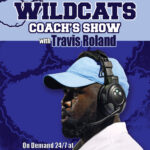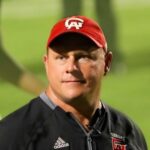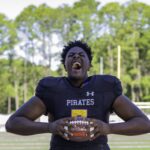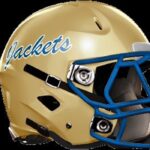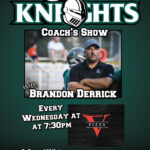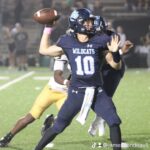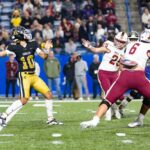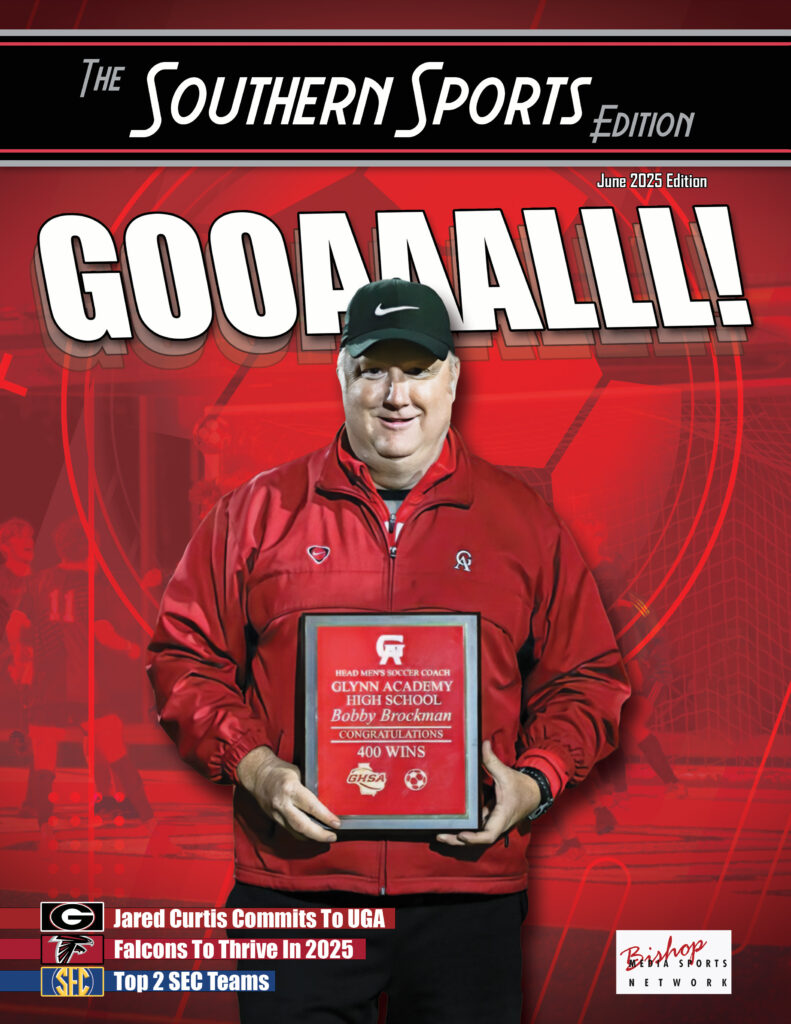Bishop Media Sports Network
Camden County Wildcats Coach’s Show w Travis Roland November 12 2024

McIntosh County Academy Buccaneers Coach’s Show w Bradley Warren November 12 2024

Terror Character
 By: Joe Delaney
By: Joe Delaney
TheSouthernSportsEdition.com news services
When you reach the playoffs in any sport for over 15 years in a row, it says something about your team and program.
That was all on the line last Friday night for the Glynn Academy Red Terrors.
After an up and down season, the Terrors found themselves down 24-21 late in the fourth quarter to the Evans Knights.
It was literally win and you’re in or lose and close but no cigar. The winner would be the region’s last team in and the loser could start pumping up basketballs.
With under 6 minutes to go in the game and trailing, the Red Terrors reached down and found that little extra they needed. They stood up and took charge of a game that they had made close with some crucial mistakes in the 3 ½ quarters before.
Behind the play of T. Y. Chisholm, Da’Sean Howard and Sean Wallace on offense and Tae Green on defense the Terrors came back to take a 28-24 victory and win a trip to take a six-hour bus ride to take on the Rome Wolves in the first round of the state playoffs.
In those final 6 minutes the Terrors showed the character of a team full of winners.
First, Howard put the team on his back and carried the ball on pretty much the same play three times in a row. The third one, a tackle breaking run went for 39 yards and the go-ahead touchdown. Tuck Tuckers extra point made it 28-24.
That left it up to the Red Terror D that had played well all night but had given up several big plays for scores.
They responded by making interceptions the last two times Evans had the ball. The last by Ervan Rowe on a 4th down and 28 Hail Mary pass. That 4th and 28 was set up by Tae Greens’ SIXTH sack of the night. The guy was a true Terror, all over the field.
Coach Rocky Hidalgo was “relieved” that the Red Terrors had won but bemoaned the errors that his Terrors had made.
All teams make errors and nobody is perfect but character stands out. In the last 6 minutes with the season on the line the Red Terrors showed character.
Can they stand up to the 5A #1 seed Rome Wolves? We will see. But the Terrors definitely have the right attitude and it begins with Coach Hidalgo’s comments following the game.
He stressed that the Terrors had to be ready not only for next Friday night in Rome but on Monday, Tuesday and Wednesday on the Glynn practice field. That’s why the Terrors are in the playoffs for the 16th consecutive season.
In the Rome Wolves, the Terrors will take on a hot team. After losing their first 2 games, the Wolves have been on a 7-game winning streak.
The latest being a 50-3 pasting of Kennesaw Mountain. The Wolves are prolific on offense scoring 59, 28, 70, 63, 35, and 50 in their last 6 games.
Defensively in those six games, they’ve given up 35 points total. The Terrors definitely will have to play their absolute best to hang with Rome.
If they make crucial errors at times in this game they could get hammered. The Terrors will head into the game at 6-4 and the regions 4th seed.
After a long season full of highlights and a few lowlights the Terrors can head up north knowing they are big underdogs.
The official website for Rome says they are playing the GLYNN COUNTY SCHOOLS. They evidently don’t even know who Glynn Academy is! Glynn should go and let it all hang out.
As the old saying goes, they’ve really got nothing to lose.
Pirate Blitz
 By: Teddy Bishop
By: Teddy Bishop
TheSouthernSportsEdition.com news services
Coach Garrett Grady’s Brunswick High Pirates readied themselves for the state playoffs by setting a school record for the most points in a single regular season.
The 43-12 victory over Bradwell Institute on Friday night gave the Pirates 460 points for the season, surpassing the 459 scored during the regular season by the 1999 team.
The ’99 Pirates went on to play for the state championship, losing to Lowndes.
This year’s Pirates averaged 46 points per game, also a school record.
The win over Bradwell earned the Pirates a perfect 8-0 record in Region 1-5A, including, of course, the region championship and a #1 seed in the state playoffs.
After an opening-season 51-41 loss to 6A Camden County, Brunswick High reeled off nine consecutive victories with wins over Wayne; Effingham; Evans; Greenbrier; Glynn Academy; Statesboro; Lakeside; South Effingham; and Bradwell.
Senior running back William Heck is the leading rusher for the Pirates with well over 1200 yards. Heck also has scored nine touchdowns.
Nigel Gardner and Josiah Gibbons—both sophomores—have also contributed heavily to the run game. Gardner has run for some 800 yards, averaging a whopping 15 yards per carry, while Gibbons is closing in on the 600-yard mark. Gardner and Gibbons have run for six and nine touchdowns, respectively.
Junior quarterback Grant Moore has completed over 70% of his passes, totaling more than 1800 yards with18 touchdowns and only 2 interceptions. He will be the All-Everything quarterback for the region and will be in the conversation for some state honors.
Senior Ja’Marious Towns, junior Heze Kent, and sophomore Waseem Murray have been Moore’s favorite targets, all with at least 30 catches, more than 500 yards receiving, and at least five touchdown catches. Senior Jordan Hicks also has double digit receptions for the Pirates.
Brunswick High’s defense hasn’t been too shabby either, allowing only 179 points, with 51 of those coming against 6A Camden—and three of Camden’s touchdowns were on short fields following a BHS fumble and two botched punts.
Senior linebacker J’Shawn Towns is the leading tackler for the Pirates, closing in on 90.
Seniors Caleb Butler and Chris Kimp have also been stalwarts on defense.
Jeremiah Robbins, Kregg Richardson, Lance Brown, and Joshua White—all seniors—have recorded multiple sacks for BHS.
The Pirates ‘Black Flag Defense’ has eight defensive touchdowns: three by Towns; two by junior Aviyon Addison; and one each by seniors Seki Ashley, Zach Miller, and Butler.
Grady’s Pirates will host the Villa Rica Wildcats in the first round of the 5A playoffs on Friday night at Glynn County Stadium.
Villa Rica finished the regular season with four wins and three losses in Region 5-A to earn the #4 seed. Overall, the Wildcats were 5-5.
Villa Rica scored 275 points in the regular season (460 for BHS) and allowed 226 (179 allowed by the Pirates).
If the Pirates get past Villa Rica in the first round, they will also host a second-round game. BHS would take on the winner between Coffee County and Jackson County. If Brunswick High and Coffee both win their first-round games, it would be a battle of top ten teams in the second round.
If Brunswick High gets to the third round of the playoffs, a coin toss would decide home-field advantage unless Brunswick High was matched against a lower seed.
But first things first. The Pirates have to beat Villa Rica in order to worry about a second-round game, much less anything beyond that.
So come on out to Glynn County Stadium on Friday night and holler for the Pirates!
Becoming A Legend
 By: Colin Lacy
By: Colin Lacy
TheSouthernSportsEdition.com news services
The air on Friday nights gets a little cooler…time change makes the sun set a little earlier; it must mean it’s time for postseason football in South Georgia.
Although the GISA has gotten a jump on the postseason party a few weeks prior to the GHSA, Southeast Bulloch Football is poised to return to the postseason for the first time since 2021.
Although there’s a ton of factors in the success for the Jackets in 2024, there’s one that seems we have said over the airwaves repeatedly and has racked up a historic season in Brooklet…Colby Smith.
On the first weekend in November, Colby Smith eclipsed the 1,000-yard rushing mark for the season becoming the first Jacket in seven years to run for more than 1K in a year.
With a 36 yard second quarter rush against Beach, the junior running back became the first SEB rusher since Chase Walker in 2017 to reach the 1,000-yard echelon, which lends itself to pretty good company.
Chase Walker is one of the most decorated players to come through Brooklet with a stellar high school career from 2014-2017 playing under three head coaches in his four-year span of Pat Collins, Steve Pennington, and Barrett Davis.
Walker not only surpassed 1,000 rushing yards as a senior in 2017 but did it in all four years as a Yellow Jacket and racked up 6,100 career yards on the ground with 28 career 100-yard rushing games.
Walker also found the endzone 91 times for rushing touchdowns, which still ranks top 15 on the all-time state of Georgia record book. To put it in perspective, Herschel Walker (regarded as one of the best players out of the state) sits 3 spots behind Walker on the all-time career rushing touchdowns list with 86.
Colby Smith has been a massive impact for Southeast Bulloch on both sides of the ball virtually his entire career. He will wrap the 2024 regular season with his 27th game played and 25th career game started.
Smith was thrust on the scene as a freshman in 2022 and started the back half of the season as a linebacker for the Jackets.
Over the last four years, Smith has seen considerable action at linebacker, safety, nickel, running back and was the backup quarterback last season and was thrown in the fire after Will Nelson’s injury.
“He’s just a hard-nosed kid,” said SEB Head Coach Jared Zito. “He physical and he’s super smart, but what gets overlooked is his athleticism and the kind of athlete he is. He’s got incredible balance, great vision, tremendous feet and is MUCH faster than people think.”
Smith has the old school football player feeling around him, and a lot of that comes from his family.
His family is one that loves the Jackets and is the picture of what a football family is.
There is not a game or event that goes by that doesn’t have his dad Cameron (who is part of the chain crew on the sidelines for the home games), his mom, Christy, and sister Courtney.
It goes beyond that too. Colby’s cousins Matt Bowen played, and Jason Bowen plays for the Jackets on the field with his Uncle Mark Bowen in the booth as an analyst on SEB’s radio broadcast on 106.5, the Boro and Aunt Christy Bowen who serves with the SEB Athletic Booster Club as the treasurer.
If that group isn’t enough, the icons of the squad that show up no matter where or the weather are his grandparents Larry and Charlotte Bowen, and when you hear someone yelling and cheering above everyone else…. it’s probably Mr. Larry.
It’s been a blast this year for me to get a front row seat to watch a historic season that Colby Smith has been putting up on the field, but the real root of high school football is the people that you get to spend each Friday night with, and it’s an absolute honor to get to see the person that Colby is and has around him.
SEC Dominance
 By: Robert Craft
By: Robert Craft
TheSouthernSportsEdition.com news services
Kirby Smart wrapped up practice Tuesday at The University of Georgia. The College Football Playoff rankings just released, naturally interviewers asked Smart if the expanding field to 12 this year changed his curiosity.
“I could care less,” Smart said. “Because what is a quality win and a quality loss right now; they’ve been known to change their mind before it comes.”
The format may be different and the field may be bigger, but Georgia has experienced this before. Texas did last year. Tennessee did two years ago. Alabama and LSU have plenty of experience with it. At this point, everyone knows the deal by now.
Smart and SEC commissioner Greg Sankey may not love Georgia’s rank at third, behind two Big Ten teams, while the Bulldogs are second in the AP and coaches polls.
There are seven SEC teams in the top 25, by far the most of any conference (in second place: the Big Ten. With four). That’s an important note for a couple of reasons:
With four in the top 12 (Georgia, Texas, Tennessee, Alabama) and a few in striking distance (No. 14 Texas A&M, No. 15 LSU, No. 16 Ole Miss), this sets up more SEC teams to make the playoffs in the future.
Second, more SEC teams will have more chances for ranked wins, or their ranked losses might not seem as bad to the rankings.
Georgia bought itself a lot of room with its win at Texas, giving it a second ranked win, and its only loss came at Alabama. It would seem the Bulldogs need only get a split of the next two games at Ole Miss and Tennessee and they would be in. Even if UGA lost both games, they would have an argument.
Texas and Tennessee also have one loss but a little less leeway.
Texas is clearly in if they win out, although losing at Texas A&M in the regular-season finale would make things dicey.
The Longhorns don’t have a win over any team in the Top 25. Vanderbilt, ranked in the AP, didn’t make the CFP rankings.
Tennessee is all set if they win out because an 11-1 record with a win at Georgia is a strong argument.
If The Vols are competitive at Georgia and lose, 10-2 with two road losses but a win against Alabama may be enough to get it done. Of course, the regular-season finale at Vanderbilt isn’t a sure win.
Texas A&M, meanwhile, is not in the field right now — 14th — but the assignment seems straightforward: Win out, including the Texas game, and the Aggies are close enough to feel good about their chances.
Important caveat: winning out is no guarantee; it depends heavily on what happens elsewhere. As Smart pointed out, the committee is known to change their mind.
Alabama at LSU this week: The loser has a third loss, which puts its Playoff hopes to sleep, while the winner is in great shape. But is the loser truly done and the winner truly in?
Alabama would have three losses to ranked teams LSU, Tennessee and Vanderbilt, if it could sneak into the CFP Top 25 with one ranked win (Georgia) and some others that might check off as good.
LSU may need this win more. It has a loss to unranked USC and the other to Texas A&M. Their best win right now is against Ole Miss.
Then there’s Ole Miss, which is almost certainly done if it loses to Georgia this week. But if Ole Miss wins, that would give it something a ranked win and winning out would mean a 10-2 record.
Still, it has a home loss to Kentucky, and other than the Georgia game, there isn’t much impressive on the resume. So, Lane Kiffin’s team would seem at the mercy of the committee and things falling its way elsewhere.
There are so many important games left and too many data points left to draw any grand conclusions. Nobody from the SEC is definitely in yet, and seven teams still have a realistic shot.
That number figures to go down after this weekend. The question is whether it continues going down over the coming weeks or the SEC ends up with a half-dozen candidates for only so many spots.
Frederica Academy Knights Coach’s Show w Brandon Derrick November 6 2024

The New Era
 By: Michael Spiers
By: Michael Spiers
TheSouthernSportsEdition.com news services
The high school football regular season has come to an end for the Camden County Wildcats but hope springs eternal as they prepare to travel to Kennesaw to begin the Georgia 6-A playoffs on Friday, November 15th.
It has been a year of big change for the Columbia-blue Cats. We saw the retirement of legendary football coach Jeff Herron not long after Camden’s unlikely run to the final four of the playoffs last year.
That was followed by the hiring of new head man, Travis Roland, out of Mainland High School in Daytona Beach, where his Buccaneers had just won the Florida 3S state championship.
Coach Roland immediately hired Grant Alford out of Florida’s Lake Minneola High School to be the Wildcats new Offensive Coordinator, and the change from Jeff Herron’s vaunted Wing-T, power running offense was converted to a more modern, pro-style attack.
The players enthusiastically took to the new schemes and produced scoring averages and statistics that would be surprising to any longtime follower of Camden County High School football.
During the five non-region matchups to start the season, the Wildcats averaged 54.4 points and 420 yards of offense per game.
Camden’s average of 213 passing yards each week during that span is probably what surprised folks the most. You read that correctly. Camden County High School is passing the football.
Those first five contests, in order, included victories over: Brunswick 51-41; East Lake (Tarpon Springs, FL) 60-15; West Broward (Pembroke Pines, FL) 52-29; Ribault (Jacksonville) 62-6; and Spruce Creek (Port Orange, FL) 47-20.
In the non-region games, Camden’s junior quarterback, Parks Riendeau, was an impressive 67/94 passing, with 1,030 passing yards, 13 touchdowns and only one interception.
Senior tight end, Elyiss Williams, who is committed to the University of Georgia, had six receiving touchdowns during that span while senior running back Jordan Hardy contributed and eye-popping 13 rushing touchdowns.
Once October arrived, so did the tough competition of GHSA Region 1-6A. But even before the region play could even begin, Hurricane Helene wreaked havoc on the schedule.
Camden ended up traveling to face the Valdosta Wildcats on a Saturday and was sent back home with 56-37 loss.
The Wildcats returned home to Chris Gillman Stadium the next week and rebounded with a 28-10 victory over the Richmond Hill Wildcats.
Camden then lost two consecutive region games, a 33-7 loss to Lowndes and a 51-41 loss to Colquitt County.
After such a promising start to the season, Camden County found itself with a 1-3 region record heading into the final contest of the year, a home matchup against Tift County High School.
In order to reach the playoffs, the Wildcats had to beat the Blue Devils and hope for a Colquitt County victory over Richmond Hill.
Camden beat Tift 38-28, and Colquitt County took care of its business. As a result, Camden County earned the fourth spot in Region 1-6A, and a trip to Kennesaw to face the 10-0 North Cobb Warriors is round one of the playoffs. These Wildcats are ready for another magical playoff run.
QB Parks Riendeau finished the regular season by completing 121 of 204 pass attempts for 1,732 yards, with 20 touchdowns and just five interceptions.
Elyiss Williams had 52 catches for 764 yards and 11 touchdowns, while sophomore wideout Sean Green finished the regular season with 41 receptions for 500 yards and four touchdowns.
Senior running back Jordan Hardy ended up with 128 carries for 831 and 17 rushing touchdowns while playing in just nine games.
Junior David ‘DC’ Coleman finished with 20 kickoff returns for 583 yards and 3 touchdowns, while adding one additional punt return for a touchdown.
On defense, Camden County was led by junior linebacker Xavier Brown with 116 total tackles, including 8 tackles for loss and a quarterback sack.
Senior outside linebacker Wayne Austell contributed 91 total tackles including six tackles for loss and two quarterback sacks.
Sophomore weakside linebacker Kingston Melton recorded 53 total tackles with six tackles for loss, in addition to a fumble recovery returned for a touchdown.
Camden County Wildcats Coach’s Show w Travis Roland November 5 2024

Trojan Quest
 By: Kenneth Harrison
By: Kenneth Harrison
TheSouthernSportsEdition.com news services
The 2024 high school football regular season is over for the Carrollton Trojans.
The top team in 6A is Carrolton (10-0) and they finished the year undefeated. The season finale was against #4 Douglas County (8-2) last week and they won 49-28.
Douglas County got within 27-21 in the second quarter before Carrolton scored three unanswered touchdowns in the second half.
The Trojans are led by four-star quarterback Julian Lewis. Lewis was 21-of-26 passing for 290 yards and two touchdowns. Kimauri Farmer rushed for 147 yards and three touchdowns and caught a 47-yard TD pass.
Messiah Satterwhite rushed for 98 yards and two touchdowns and caught a 26-yard pass. The game decided the No. 1 seed from Region 2.
Lewis is ranked as the #14 player in Georgia for the class of 2025 and he is committed to USC. Lewis did take his fourth visit to Colorado in late October so he might not stay committed to USC for much longer. He turned seventeen in September and he reclassified in January 2024 to graduate one year early.
After the Elite 11 Finals in June he ranked seventh out of that group. He also appeared on the cover of Sports Illustrated in October 2023. I’m saying that to say, he’s kind of a big deal.
Julian’s father, T.C., has spent a lot of time preparing him to be a big time QB prospect.
Carrolton’s head coach is Joey King. King spent five years as the head coach at Cartersville, where he won two state championships with Trevor Lawrence. He was the fastest in state history to reach 50 wins, in 52 games.
King left high school to become the wide receivers coach at Coastal Carolina from 2019-21. Once King took over as Carrolton’s head coach T.C. moved Julian to Carrolton for eighth grade.
Lewis attended Pace Academy before that, which is a private school in Atlanta.
“If a kid is trying to go to Harvard, I need him enrolled in that kind of [school],” T.C. says, “but if he’s trying to go play at Alabama, Georgia, wherever, then let me put him in AP Football.”
The GHSA moved the start of the playoffs back in early October due to Hurricane Helene. They moved the end of the regular season from Nov. 1 to Nov. 8 and pushed the opening round of the state playoffs back to Nov. 15 and16.
GHSA said the week of Nov. 8 will be used for makeup games. Schools that completed games without schedule interruptions and are advancing to the postseason will have an open week before the first round of the playoffs.
Carrolton’s next game will be 11/15 against Dacula. The Falcons are 4-6 and ranked fourth in Region 8. This should be an easy blow-out win for the Trojans. They advanced to the state championship game in 2022 and they look to do that again in 2024.
I think they are talented enough to reach the state championship but I think #2 Buford (9-1) is the best team. Their only loss on the season was the season opener to the top team in 5A, Milton.
